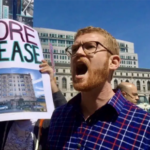Analyze Before You Up-zone! Analyzing development is key to ASF’s platform and engagement with the county. We offered proof of concept last year with a study by Arlington Analytics, focusing on Missing Middle (MM) duplexes the county was advocating as part of a major zoning review. That June analysis by Dr. Jon Huntley and Kody Carmody found that only six of Arlington’s 60 civic associations would likely offer market conditions that yielded new duplex prices at $525,000 or below. This would make them affordable to middle-income households earning $117,000 per year, the county’s implied target audience at the time. The study also projected such duplexes may cost “significantly more,” noting “the high price of both land and competing housing alternatives.” The County Board dismissed concerns raised about affordability, yet since July they have claimed their initiative will not deliver middle-income housing; it will only fill a purported gap in housing “types.”
Missing Middle in Practice; Taxpayers and Diversity Cohorts Take the Hit. Dr. Huntley (with ASF’s Mary Glass) has now completed a study of the Towns of 24th townhomes, now underway in Green Valley, one of the six neighborhoods he projected might yield affordable (middle-income) housing. The developer is offering four townhome units in two quadplexes, replacing two single-family homes valued at $675,000 each. While the Huntley/Glass report did not assess affordability, marketing materials currently show each townhome “starting at $800,000,” meaning owners will need to make $138,977 per year to get a mortgage.

The county — with no evidence to support its claims — is indicating MM homes are a pathway to diversity. Yet consider 2014-18 U.S. Census data cited in Arlington’s Missing Middle Research Bulletin #2, which shows Arlington average annual household incomes:
- African-American – $58,878/year
- Hispanic – $77,743
- Non-Hispanic white – $134,723
Based on these averages, Towns of 24th owners are more likely than not to be white, or to be persons of any race/ethnicity relocating from elsewhere. Other data show the townhome price range falls well above income levels of current residents who are over 65, those who occupy federal or county government jobs, and those who are single parents or immigrants.
Affordability has two angles: affordable to the purchaser, as discussed above, and affordable to the county in terms of services for new residents. Assessing the latter, Huntley estimated “fiscal costs of this development from 2022-2031 at about $27,000 excluding new school construction costs, and $140,000 [if we include] construction.” While the estimated costs are modest, they confirm ASF views (and GMU studies, p. 11) that residential development poses net costs that need to be better captured before approving new zoning that will add to the current (and very unpredictable) budget deficit. The estimates complement those contained in Huntley’s site-specific survey of condo development at Merion Pike West showing net costs for taxpayers of $32-37 million a year.
Environmental Loss. The county has touted environmental benefits of MM housing. Huntley and Glass (who also works with Arlington Tree Action Group) found Towns of 24th will kill approximately 40 mature Leyland Cypress trees on adjacent property. They calculated $647 per year as the loss due to measurable benefits, “including carbon, stormwater, and air pollution abatement [and] direct and indirect energy savings.” Intangible benefits such as “property value, health, and aesthetic/recreational benefits” were not included; visit the photo gallery on ASF’s Missing Middle page to see the trees’ screening value and beauty.
Of note, the most recent county survey of tree canopy showed 27% coverage in Green Valley, well below other single-family neighborhoods. The study also documents increased flood risk. “The developer plans to maintain about 6,089 square feet (0.14 acres) of open landscape, which is a decrease in permeable space of about 55%,” for which there is no easy formula to assign value.
Is This Our Future? As projected by this study, new MM housing is not likely to boost diversity or affordability. It will likely increase impervious surface and tree loss, and it is more likely to produce negative fiscal impact. The cumulative effects in Arlington spell trouble.
ASF finds no compelling case for this kind of up-zoning and calls on the county to ensure similar analysis before going any further with residential up-zoning plans including the Missing Middle study.

